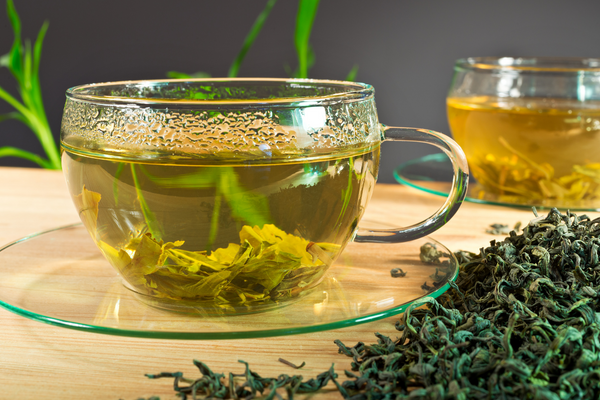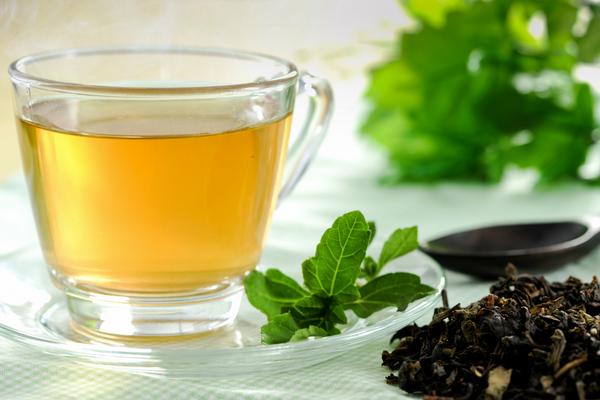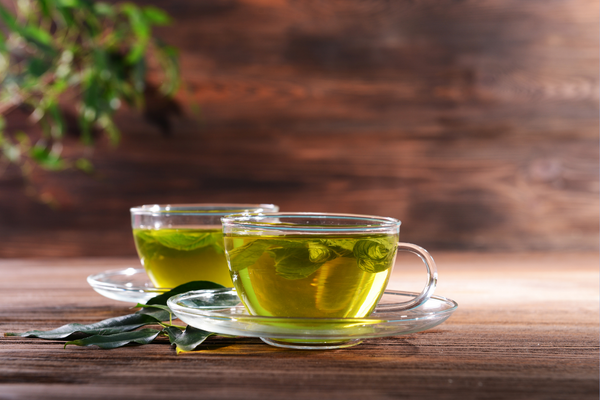Green tea – By Malsha – eLanka

Green tea is a type of tea made from the Camellia sinensis plant. It is primarily produced in China, Japan, and Taiwan. Unlike black tea, which is heavily oxidized, green tea is only minimally oxidized during processing, which helps to preserve the natural compounds and antioxidants present in the tea leaves.
Green tea is known for its health benefits, which include improving brain function, reducing the risk of cancer, lowering the risk of heart disease, and promoting weight loss. This is largely due to the high levels of catechins, which are powerful antioxidants, and caffeine, which can improve brain function and boost metabolism.
Green tea is traditionally brewed using water that is around 70-80°C (160-180°F), for about 1-3 minutes. It can be enjoyed on its own or with a variety of flavorings, such as lemon, honey, or mint.
The health benefits of green tea
Green tea has a number of potential health benefits due to the presence of natural compounds, including antioxidants and polyphenols, that have been shown to have positive effects on the body. Here are some of the potential health benefits of green tea:
- Improving brain function: Green tea contains caffeine, which can help to improve alertness and concentration. Additionally, it also contains the amino acid L-theanine, which can help to reduce anxiety and promote relaxation.
- Reducing the risk of cancer: Green tea is high in antioxidants called catechins, which have been shown to help protect cells from damage and reduce the risk of certain types of cancer, including breast, prostate, and colorectal cancer.
- Lowering the risk of heart disease: Studies have suggested that green tea may help to reduce the risk of heart disease by improving cholesterol levels, reducing inflammation, and lowering blood pressure.
- Promoting weight loss: Some studies have found that the catechins in green tea can help to boost metabolism and increase fat burning, which may help with weight loss.
- Supporting healthy aging: The antioxidants in green tea may help to protect the body against damage from free radicals, which can contribute to aging and disease.
It is worth noting that while green tea has many potential health benefits, more research is needed to fully understand its effects on the body. Additionally, it is important to keep in mind that green tea is not a cure-all and should be used as part of a healthy and balanced diet and lifestyle.

There are many different varieties of green tea, each with its own unique flavor and aroma. Some of the most popular types of green tea include:
- Sencha: This is a common type of Japanese green tea, which is made by steaming the tea leaves. It has a fresh, grassy flavor and is often used for everyday drinking.
- Matcha: This is a type of powdered green tea that is often used in traditional Japanese tea ceremonies. It has a rich, umami flavor and is made by grinding the tea leaves into a fine powder.
- Gyokuro: This is a high-quality Japanese green tea that is grown in the shade, which gives it a sweet, mellow flavor. It is often considered to be one of the finest green teas in Japan.
- Dragonwell: This is a type of Chinese green tea that is grown in the Hangzhou region. It has a nutty, sweet flavor and is often considered to be one of the best green teas in China.
- Gunpowder: This is a type of Chinese green tea that is rolled into small pellets, which resemble gunpowder. It has a smoky, bold flavor and is often used in Moroccan mint tea.
- Bancha: This is a common Japanese green tea that is made from older tea leaves. It has a more robust, earthy flavor and is often used for cooking.
These are just a few examples of the many different types of green tea available. Each variety has its own unique flavor profile and can be enjoyed on its own or with added flavorings like lemon or honey.
Green tea is a low-calorie drink that is rich in a number of beneficial nutrients, including:
- Catechins: Green tea is rich in catechins, which are a type of antioxidant that may help to protect against cell damage and reduce the risk of chronic diseases.
- Caffeine: Green tea contains caffeine, which can help to improve mental alertness and concentration.
- L-theanine: This amino acid is found in green tea and has been shown to help reduce stress and improve mental clarity.
- Vitamin C: Green tea contains small amounts of vitamin C, which is an important antioxidant that helps to support the immune system.
- Minerals: Green tea contains small amounts of minerals such as potassium, calcium, and magnesium.
It’s important to note that the specific nutritional content of green tea can vary depending on the brand, brewing method, and other factors. Additionally, green tea is typically consumed in small amounts, so it may not provide significant amounts of these nutrients on its own. However, incorporating green tea as part of a healthy and balanced diet can be a beneficial way to boost your intake of antioxidants and other beneficial compounds.

Green tea may be helpful in reducing body fat as it contains natural compounds like catechins and caffeine that have been shown to boost metabolism and increase fat burning. Here are some ways to incorporate green tea into your diet to potentially help reduce body fat:
- Drink green tea regularly: Drinking green tea regularly throughout the day may help to boost metabolism and increase fat burning. Aim for 2-3 cups of green tea per day.
- Replace sugary drinks with green tea: Swap sugary drinks like soda or juice with green tea to reduce your calorie intake and potentially help with weight loss.
- Combine green tea with exercise: Combining green tea with regular exercise may help to increase fat burning and improve overall health. Try drinking green tea before a workout to help boost energy and metabolism.
- Avoid adding sugar or cream: Adding sugar or cream to green tea can add unnecessary calories and negate the potential weight loss benefits. Enjoy green tea plain or with a squeeze of lemon for added flavor.
- Choose high-quality green tea: Choosing high-quality green tea with a high concentration of catechins may help to maximize the potential weight loss benefits. Look for tea that is fresh, fragrant, and contains minimal additives.
It’s important to note that green tea should not be used as a sole method for weight loss, and that maintaining a healthy and balanced diet and regular exercise routine are also important for achieving and maintaining a healthy weight.
Green tea is a natural source of antioxidants and other beneficial compounds that may help to improve skin health. Here are some ways in which green tea may help improve skin health:
- Protects against UV damage: Green tea contains polyphenols, which are antioxidants that may help protect against UV damage from the sun. UV damage can lead to premature aging of the skin, including wrinkles and sun spots.
- Reduces inflammation: Green tea has anti-inflammatory properties, which may help to reduce inflammation in the skin. Inflammation can contribute to a variety of skin issues, including acne, rosacea, and eczema.
- Boosts collagen production: Collagen is a protein that helps to keep skin firm and elastic. Green tea contains compounds that may help to boost collagen production in the skin, which can help to reduce the appearance of fine lines and wrinkles.
- Improves skin hydration: Green tea contains natural compounds that may help to improve skin hydration, which can help to keep skin looking plump and healthy.
- Fights free radicals: Free radicals are unstable molecules that can cause damage to cells and contribute to aging. Green tea contains antioxidants that help to neutralize free radicals, which can help to prevent damage to the skin.
To use green tea for improving skin health, you can try incorporating it into your skincare routine by using a green tea-infused face wash or moisturizer. Alternatively, you can apply brewed green tea directly to the skin as a toner or face mask. Drinking green tea regularly can also provide benefits for skin health from the inside out.
There are several ways to use green tea, depending on the desired effect. Here are some common methods:
- Drink it: One of the simplest and most common ways to use green tea is to drink it. To make green tea, boil water and let it cool for a few minutes, then add 1-2 teaspoons of loose-leaf green tea or a green tea bag to the water. Steep for 2-3 minutes and then strain or remove the tea bag. You can enjoy green tea hot or cold.
- Use it in cooking: Green tea can be used in cooking to add flavor and nutritional benefits. For example, you can use green tea to flavor rice or to make a marinade for fish or chicken.
- Apply it topically: Green tea can be applied topically to the skin to help improve skin health. To do this, steep a green tea bag in hot water for a few minutes, then remove the tea bag and let it cool. Apply the tea to your face with a cotton ball as a toner, or use it to make a green tea face mask by mixing the tea with honey and applying it to your face for 10-15 minutes.
- Take green tea supplements: Green tea supplements are available in capsule or liquid form, and can be taken as a convenient way to get the health benefits of green tea.
It’s important to note that green tea contains caffeine and can have some potential side effects for some people, such as insomnia, anxiety, or stomach upset. It’s also important to talk to your doctor before using green tea supplements, especially if you are pregnant or taking medications.







